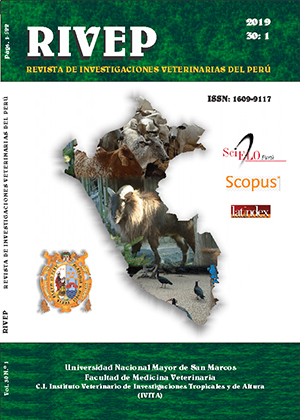Effect of low-density lipoproteins and trehalose on antioxidant enzymatic activity of cryopreserved bovine semen
DOI:
https://doi.org/10.15381/rivep.v30i1.15680Keywords:
antioxidants; cryopreservation of semen; oxidative stressAbstract
The aim of this study was to evaluate the enzymatic antioxidant capacity of cryopreserved bovine semen with different sources of low-density lipoproteins (LDL) and trehalose (T). Ten ejaculates selected from five bulls were cryopreserved under the treatments: LDL (8% m/v), T (100 mM), TLDL (100 mM T and 8% m/v LDL), centrifuged egg yolk (CEY, 20% v/v) and egg yolk (EY, 20% v/v) as control treatment. After the semen thawing process, the antioxidant enzymatic capacity of catalase (CAT), superoxide dismutase (SOD) and glutathione peroxidase (GPx) of bovine semen were evaluated by spectrophotometry plus its relationship with spermatic kinetic parameters. A completely random model was used. The normality of the variables was validated by the Kolmogorov- Smirnov test. The sources of variation were evaluated through a mixed model. The comparison of the adjusted means between the treatments was carried out using the Tukey test. EY, CEY and LDL treatments increased the antioxidant activity of CAT and GPx and correlated positively with the kinetic parameters and the integrity of the sperm membrane (p<0.05). No differences were found between LDL and TLDL with respect to the activity of CAT and GPx. The enzymatic activity of SOD was similar in all treatments compared to the control (EY). T did not improve the antioxidant activity of the enzymes used. It is concluded that the diluents with EY, CEY and LDL improve the antioxidant activity of CAT and GPx, generating a positive correlation with the seminal quality.
Downloads
Downloads
Published
Issue
Section
License
Copyright (c) 2019 Benjamín A. Rojano, Elizabeth Varela G., Giovanni Restrepo B.

This work is licensed under a Creative Commons Attribution-NonCommercial-ShareAlike 4.0 International License.
AUTHORS RETAIN THEIR RIGHTS:
a. Authors retain their trade mark rights and patent, and also on any process or procedure described in the article.
b. Authors retain their right to share, copy, distribute, perform and publicly communicate their article (eg, to place their article in an institutional repository or publish it in a book), with an acknowledgment of its initial publication in the Revista de Investigaciones Veterinarias del Perú (RIVEP).
c. Authors retain theirs right to make a subsequent publication of their work, to use the article or any part thereof (eg a compilation of his papers, lecture notes, thesis, or a book), always indicating the source of publication (the originator of the work, journal, volume, number and date).



